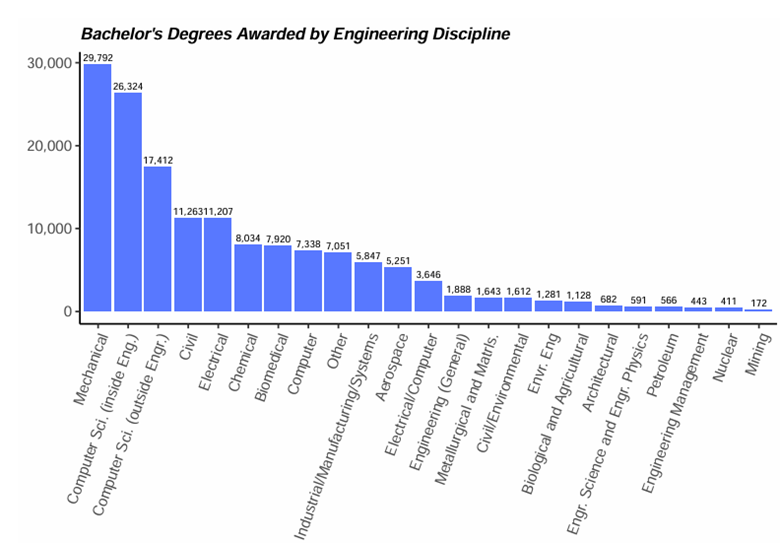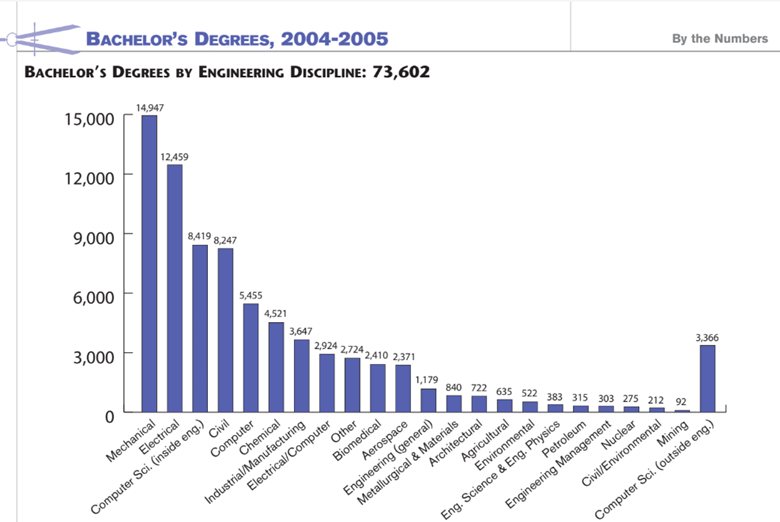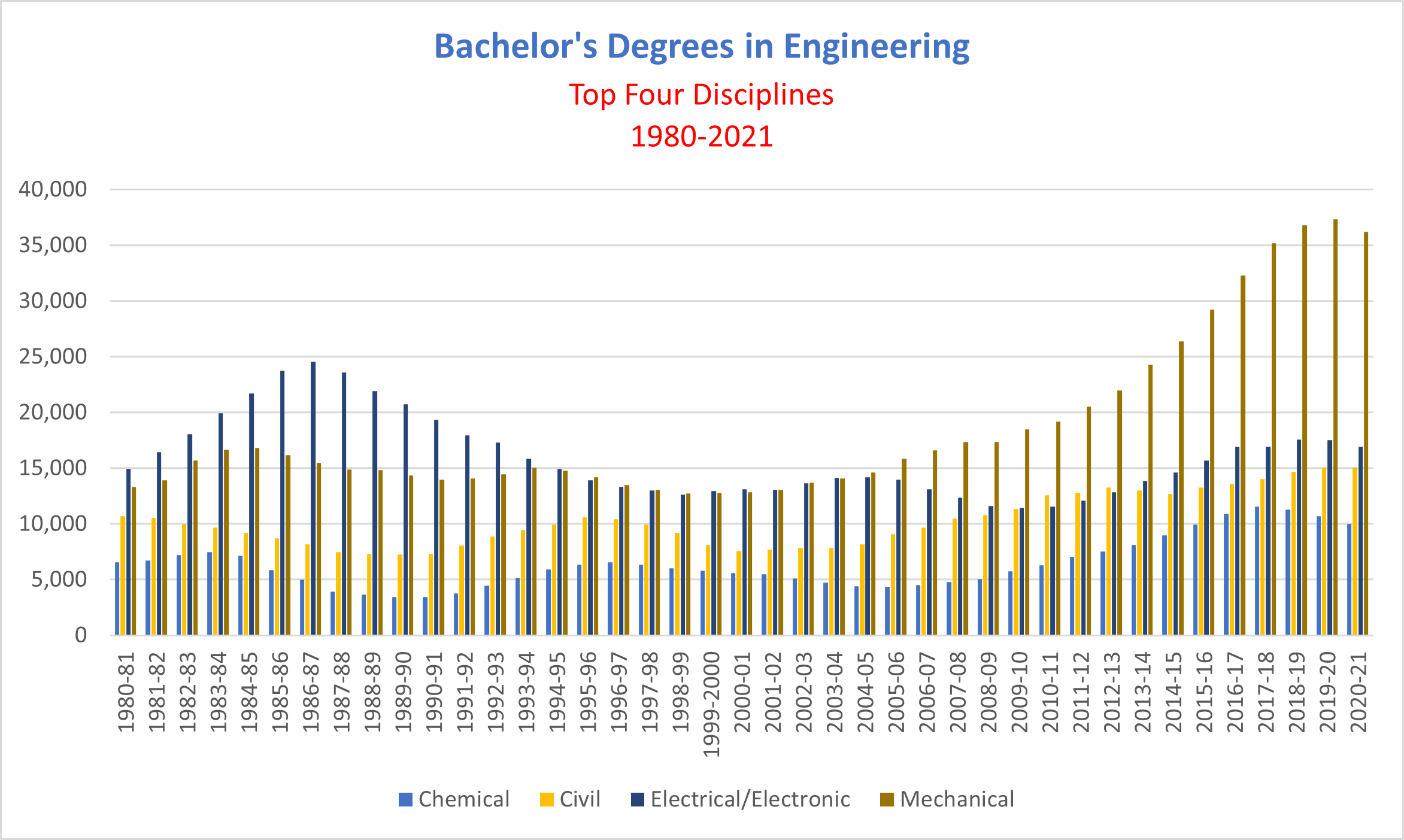Engineering Disciplines: How Have They Changed Over the Years?
Anyone who has considered a career in engineering has also probably contemplated which type of engineering to pursue. In the early days of formal engineering education (i.e., the 19th century and early 20th century), the choices were limited to a few primary disciplines, such as civil, mechanical, and electrical engineering. As technology advanced, other disciplines, such as chemical, industrial, and aerospace engineering, became available. Today, engineering students can choose from a bevy of options, with significant overlap among disciplines.
What Are the Top Disciplines?
In the U.S., more mechanical engineering degrees were earned than any other engineering discipline, according to the 2023 Engineering & Engineering Technology by the Numbers report by the American Society of Engineering Education, followed closely by two types of computer science (one inside and one outside engineering). Civil, electrical, biomedical and computer engineering followed. If the two computer science degrees were combined, they would constitute the greatest number of degrees, though some would argue that computer science is not an engineering discipline and should not be included in engineering degree statistics.

Mechanical engineering has held its lead over a couple of decades. It was the top choice in 2005 for engineering bachelor’s degrees, though the landscape was a bit different. Electrical engineering was a close second, and computer science (inside engineering) was third, followed by civil engineering.

Another interesting development over the last couple of decades is the overall growth in engineering degrees. According to the ASEE data, approximately 73,600 bachelor’s degrees in engineering were granted in 2005. By 2023, this number had risen to approximately 134,000, an increase of over 80 percent.
Looking back further, electrical engineering logged the most U.S. bachelor’s degrees throughout the 1980s and most of the 1990s. Mechanical engineering took over as the leading discipline in the early 21st century, perhaps as different variations of electrical and computer engineering provided other options, decreasing the number of traditional EE degrees. While ASEE did not have data available for this period, the National Center for Education Statistics maintains data for the top four engineering disciplines dating back to 1960.

Changes in the Digital Age
Clearly, the computer has altered the course of engineering education. In addition to the growth of degrees in computer engineering and other computer-related areas, other engineering curricula have also changed in the digital age.
Many an engineering student in the late 20th century took a course in FORTRAN programming. Electrical engineering and computer-focused students might have also studied other programming languages.
As other programming languages became available, the FORTRAN requirement was dropped at most schools. Programming, in general, has also taken on a different twist. A quick check of engineering curricula around the U.S. indicates that programming is no longer required for many engineering disciplines other than those directly related to computer studies. Instead, many schools offer courses in computer applications, such as CAD, BIM, visualization and other tools.
Is Licensure Required?
Engineering graduates often wonder whether they should pursue licensing as a professional engineer (P.E.). The decision is often influenced by whether a P.E. license will be required in the chosen career path. Engineers who prepare, sign, seal and submit drawings for buildings, public works, and other public facilities are typically required to have a P.E. license.
For engineers working in other settings, a P.E. may not be required, but it still offers benefits. According to the National Council of Examiners for Engineering and Surveying, a P.E. license offers at least four types of benefits:
- Recognition–demonstrating a commitment to the engineering profession and providing networking opportunities for career advancement
- Growth—providing career advancement opportunities
- Mobility–opening doors to potential new work opportunities
- Authority—in addition to signing drawings, a P.E. can have more authority and credibility in the workplace, or as an engineering consultant or expert witness.
While licensure may be most common in civil engineering, mechanical, electrical, and architectural engineering and other disciplines continue to find value in P.E. licenses. A P.E. exam for computer engineering was introduced in 2003.
Highly Valued Traits of Engineers
An engineering degree continues to offer numerous opportunities for those entering the working world. For many, this means working directly in their chosen field of engineering. For others, it may lead to opportunities not directly related to their college major, but still requiring an engineering background. Some may pursue post-graduate studies, and perhaps find opportunities in academia. Others may find themselves working in totally different areas, such as finance, real estate, or management. In any event, the study of engineering instills traits such as problem solving, organization skills, concern for public welfare, and integrity. Organizations large and small find great value in these traits.
